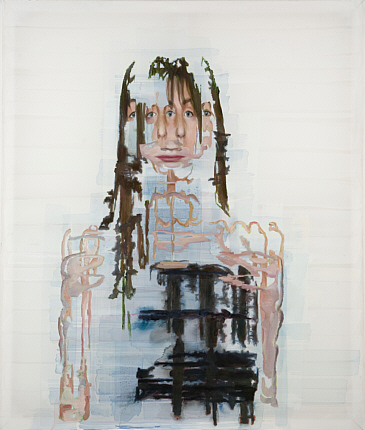dénes ghyczy
hybrids4 April – 24 May 2008
Curated by Marc Wellmann
Opening 3 April 2008, 6–9 pm
-> Einladung_denes_ghycz.pdf | 451 KB

Rezna2-2 1, 2008, 155 x 130 cm, oil and acrylic on viscose silk
In his exhibition at berlin art scouts, the German-Hungarian painter Dénes Ghyczy shows current images of heads and figures that are dissolved into complex faceted structures, some of which are composed from multiple motifs. In this, he does not pursue the fragmentation of objects in a futurist or cubist sense, such as in the representation of speed or the multiple viewing angles for an object. Dénes Ghyczy’s path leads us into a world behind the surface, into a depth that is more mentally than visibly fathomable.
Lately, the concepts of modern neuroscience have given up the notion of an unyielding core individuality (literally the undividable, from the Latin dividere). Instead, the idea has taken hold that the I is an imaginary creation that arises from intangible precognitive neuronal processes. The concept of a congruent, inwardly centered subject, this bulwark
Lately, the concepts of modern neuroscience have given up the notion of an unyielding core individuality (literally the undividable, from the Latin dividere). Instead, the idea has taken hold that the I is an imaginary creation that arises from intangible precognitive neuronal processes. The concept of a congruent, inwardly centered subject, this bulwark
of holistic self-awareness that Freud erstwhile posited, has become porous. In today’s psychology and neurology, identity is seen to be an intersection of relational networks, discourses and narratives that can overlap in multidimensional facets of identity and are subject to a continuous dynamic.
In his pictures, Dénes Ghyczy develops an image of the contemporary human in his heterogeneous and hybrid identity, torn apart by the intensity of the media age. In modern communication and entertainment technology, such as the internet, television or computer games, we are subjected to a flood of symbols, increasingly blurring the line between reality and fiction.
Dénes Ghyczy completed a classical education at the art academies of Budapest and Brussels, and the quality of his craftsmanship is at a remarkable level. This allows him to transcribe the finest of nuances, lighting details, hues and shadows to a world of color that can hold its ground effortlessly next to the digitally remastered photographic originals. The merging, overlapping or interwoven elements are based on a highly calculated, downright surgical process, in which painting gestures are merely hinted at. The artist sees his course of fragmentation, warping and recombination as a structuralist process in the sense of Roland Barthes’ concept of Simulacrum, creating a world that wants to make reality more accessible instead of just copying it.
In his pictures, Dénes Ghyczy develops an image of the contemporary human in his heterogeneous and hybrid identity, torn apart by the intensity of the media age. In modern communication and entertainment technology, such as the internet, television or computer games, we are subjected to a flood of symbols, increasingly blurring the line between reality and fiction.
Dénes Ghyczy completed a classical education at the art academies of Budapest and Brussels, and the quality of his craftsmanship is at a remarkable level. This allows him to transcribe the finest of nuances, lighting details, hues and shadows to a world of color that can hold its ground effortlessly next to the digitally remastered photographic originals. The merging, overlapping or interwoven elements are based on a highly calculated, downright surgical process, in which painting gestures are merely hinted at. The artist sees his course of fragmentation, warping and recombination as a structuralist process in the sense of Roland Barthes’ concept of Simulacrum, creating a world that wants to make reality more accessible instead of just copying it.

Kate88, 2008, 130 x 170 cm, oil and acrylic on viscose silk
- born 1970 in Diepholz
1972
- emigration to Netherlands
1988 -1990
- Gerrit Rietveld Akademie, Amsterdam
1990 -1991
- Akademie der Bildenden Künste, Budapest
1991 -1992
- St. Luc Akademie, Brüssel
1992 -2005
- lived in Budapest
2005 -
- lives in Berlin
-
2008
- Mentale Collage, Erika Deák Galerie, Budapest
2007 - Siamesische Savants, Emmanuel Walderdorff Galerie, Köln
2006
- Beobachtungen, Vizivárosi Galerie, Budapest (with Tibor Iski Kocsis)
2005
- Zweite Schicht, Emmanuel Walderdorff Galerie, Köln
2004
- Zwischen zwei Welten, Erika Deák Galerie, Budapest
- Spiegelungen, Kunstraum die Rampe, Bielefeld
2003
- Das Glas und das Mädchen, Ignác Tragor Museum, Vác, Ungarn
- Vakuum - Raum, Goethe-Institut, Budapest
- Fragil, Erika Deák Galerie, Budapest
- Unzerbrechlich, Emmanuel Walderdorff Galerie, Köln (Katalog)
2001
- Mit anderen Augen, Szinyei Salon, Budapest
2000
- Teilung, Illárium Galerie, Budapest
-
2007
- Kunstraum B, Kiel (mit Lilla von Puttkamer)
- Die Drostei, Pinneberg
- Life Spotting, Vonderbank Galerie, Berlin
(with Jörg Lohse and Anne Wölk) - Zeit’n’Geist II, Vonderbank Galerie, Hamburg
2006
- Figure & Space, Vonderbank Galerie, Berlin
2005
- Analog, Szinyei Salon, Budapest
(with Tamás Fuchs and László Györffy)
2004
- Medienfabrik: Interface, ehemalige Zsolnay Fabrik, Pécs, Ungarn
- Technoreal?, Institut für zeitgenössische Kunst, Dunaújváros, Ungarn
2003
- Portrait, Erika Deák Galerie, Budapest
- Cream 2003, MEO, Budapest
2002
- Bisector, Cadre Rouge Galerie, Budapest
- Geerbter Realismus, Städtische Galerie, Szombathely, Ungarn (Katalog)
2001
- Aritmia 9 - Konstellation, Institut für zeitgenössische Kunst, Dunaújváros, Ungarn
2000 - Rotation, Várfok Galerie, Budapest
- Art Expo-Frisch, Kunstmühle, Szentendre, Ungarn (Katalog)
- Dialog - ungarische Malerei um die Jahrtausendwende, Kunsthalle, Budapest